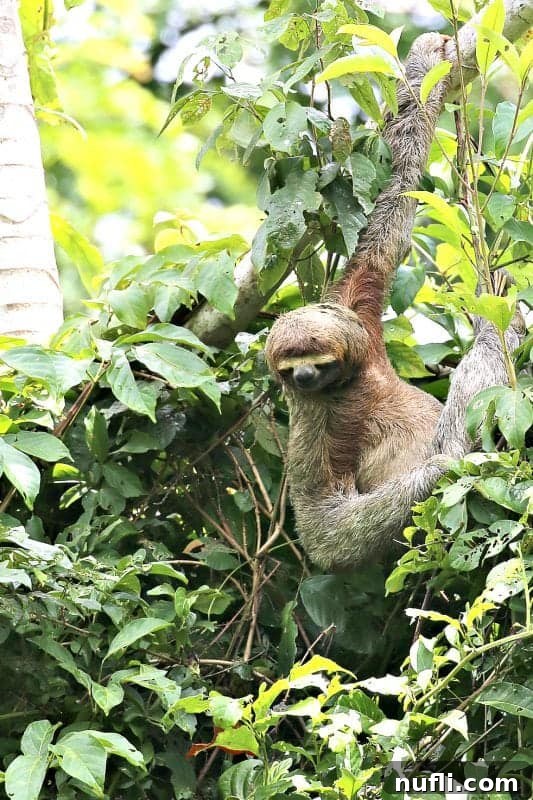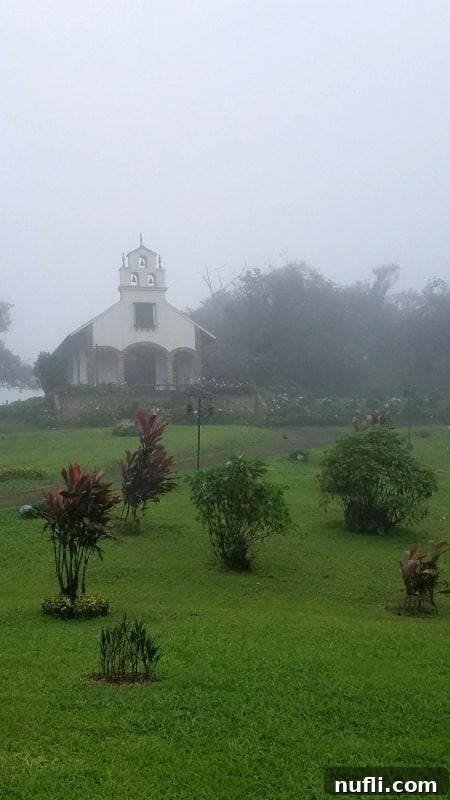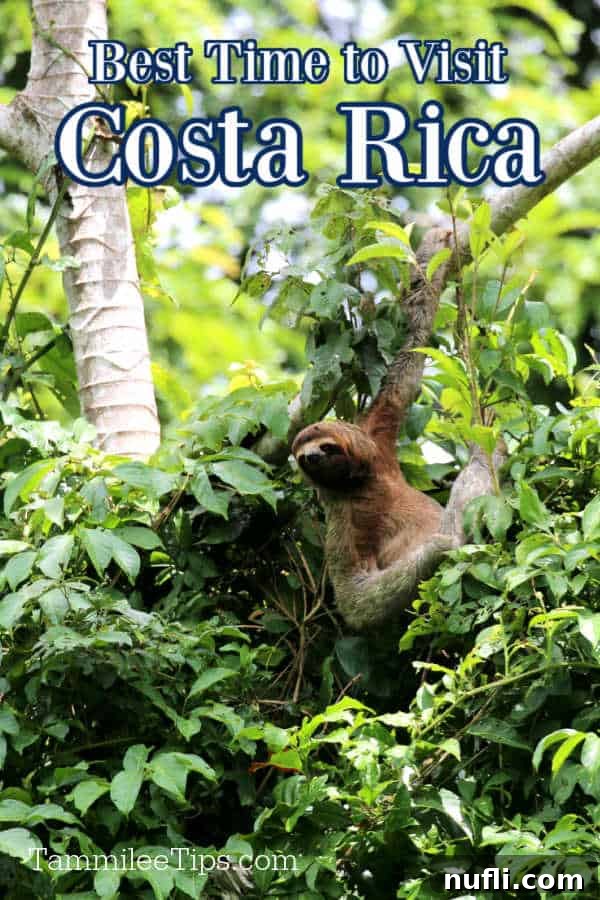Are you dreaming of an unforgettable adventure in Costa Rica, a land famed for its breathtaking biodiversity, vibrant culture, and stunning natural beauty? If so, a crucial question likely comes to mind: “When is the best time to travel to Costa Rica?” The answer, as many seasoned travelers will tell you, is wonderfully complex and depends heavily on what kind of experience you seek, which regions you plan to explore, and even your budget. This comprehensive guide will help you navigate Costa Rica’s unique climate patterns and microclimates, ensuring you pick the perfect time for your Pura Vida getaway.

Quick Planning Resources: Short on time? Here are some top picks to kickstart your Costa Rica trip planning:
- 🏨 Find the Best Hotels and Vacation Rentals
- 📍 Discover Incredible Tours and Activities
Understanding Costa Rica’s Climate: The Wet vs. Dry Seasons
Costa Rica, being a tropical country situated close to the equator, experiences two primary seasons rather than four: the dry season and the wet, or “green,” season. These seasons dictate the general weather patterns across much of the nation, though as we’ll explore, microclimates introduce fascinating variations.
The Dry Season: December to April (Verano)
Often referred to as “Verano” (summer) by locals, the dry season runs from roughly December through April. This period is characterized by abundant sunshine, minimal rainfall, and generally lower humidity, especially in the Pacific and Central regions. Temperatures across the coastal areas typically range from 85 to 95 degrees Fahrenheit (29-35°C), while central valleys enjoy a more moderate 75-80°F (24-27°C).
Pros of Visiting During the Dry Season:
- Ideal Beach Weather: Perfect for sunbathing, swimming, and enjoying Costa Rica’s stunning coastlines without interruption.
- Optimal for Outdoor Activities: Excellent conditions for hiking, zip-lining, white-water rafting (though rivers may be lower), and exploring national parks.
- Wildlife Spotting: Many animals are more active and easier to spot as they gather around remaining water sources. It’s a prime time for birdwatching and observing monkeys, sloths, and other creatures.
- Guaranteed Sunshine: For those seeking a vacation free from rain, the dry season offers the highest probability of clear skies.
Cons of Visiting During the Dry Season:
- Higher Prices & Crowds: This is peak tourist season, especially around Christmas, New Year’s, and Easter. Expect higher prices for flights, accommodations, and tours, along with more crowded attractions.
- “Brown Season” in Some Areas: While pleasant for visitors, the lack of rain can turn some landscapes, particularly in the Guanacaste region, from lush green to a drier, browner hue.
The Wet Season: May to November (Green Season)
Conversely, the wet season, often affectionately called the “green season,” spans from May to November. This period brings more consistent rainfall, transforming the landscape into an incredibly lush and vibrant emerald paradise. While the term “wet season” might sound daunting, it rarely means continuous, all-day rain. Typically, mornings are sunny and clear, with showers developing in the afternoon or evening. Temperatures remain warm, though humidity levels are higher.
Pros of Visiting During the Green Season:
- Lush Scenery: The entire country bursts into life with vibrant foliage, making for incredibly picturesque views and photography opportunities.
- Fewer Crowds & Better Deals: With fewer tourists, you’ll often find more competitive prices on flights and accommodations, and enjoy attractions with more tranquility.
- Excellent for Water Activities: Rivers swell, creating thrilling conditions for white-water rafting and kayaking. Waterfalls are at their most spectacular.
- Enhanced Wildlife Activity: The abundance of food and water means many animals are very active. It’s also turtle nesting season on some coasts and whale watching season in parts of the Pacific.
- Experience the “Pura Vida” Vibe: With the slower pace, you might get a more authentic local experience.
Cons of Visiting During the Green Season:
- Afternoon Rain: While often predictable, afternoon showers can disrupt outdoor plans. Some remote roads may become challenging or even impassable due to flooding.
- Increased Humidity: The combination of heat and rain can lead to higher humidity, which some travelers might find less comfortable.
Navigating Costa Rica’s Diverse Microclimates: Where and When to Go
Beyond the general wet and dry seasons, Costa Rica’s varied topography creates distinct microclimates. This means that at any given time, different regions of the country can experience vastly different weather conditions. Understanding these zones is key to planning your perfect trip.
The Sizzling Torrid Zone: Pacific Coasts & Caribbean Shores
This zone encompasses the northern Pacific area of Guanacaste, the central and south Pacific coasts, and the Atlantic (Caribbean) coast. Generally, these regions are characterized by higher humidity and hot temperatures, typically ranging from 85 to 95 degrees Fahrenheit (29-35°C). When it rains, the humidity can feel even more intense.
Guanacaste: The Golden Coast
Guanacaste, often referred to as Costa Rica’s “Golden Coast,” stands out as a prime destination for many visitors. Its appeal stems from a combination of pristine Pacific beaches, abundant sunshine, and the convenience of Daniel Oduber Quirós International Airport (LIR) in Liberia, which offers direct flights from numerous international cities. This region is particularly famous for its luxurious all-inclusive resorts, making it an ideal choice for those seeking a hassle-free, pampered vacation. During the dry season (December-April), Guanacaste practically guarantees endless sunny days and temperatures consistently in the mid-80s to low-90s Fahrenheit (29-35°C), perfect for sunbathing, swimming, and exploring the coastline. The evenings often bring refreshing breezes. However, this popularity also means higher prices and larger crowds, particularly during peak holiday periods. If you prefer a more tranquil experience with lush green scenery, consider visiting during the shoulder months of the green season, such as May or November. While you might encounter occasional afternoon showers, these are usually brief, leaving plenty of time for outdoor activities, and the landscape transforms into a vibrant, verdant paradise, often with fewer tourists and more competitive prices.
Central and South Pacific: Lush Jungles and Surfing Havens
Stretching from the southern tip of the Nicoya Peninsula down to Golfito and the Osa Peninsula in the south, this region is a magnet for adventurers, surfers, and wildlife enthusiasts. Popular destinations include Manuel Antonio, Dominical, Uvita, and Drake Bay. While December through April marks the dry season here, it’s worth noting that it can also be the “brown season” in some areas, as the intense sun causes some vegetation to dry out and dust to accumulate. However, this is also when whale watching peaks for Humpback whales migrating from the north, particularly from December to March. The green season (May-November) transforms this area into a vibrant, emerald wonderland, perfect for exploring rainforests and enjoying spectacular waterfalls. Whale watching for Southern Humpback whales is prominent from July to November. If you are traveling to this area, a fantastic time to visit is near the beginning of December. You’ll likely catch the tail end of the green season’s lushness before the full dry season sets in, offering the best of both worlds – vibrant landscapes and receding rains.
The Caribbean Coast: A Unique Tropical Experience
The Caribbean coast of Costa Rica, including destinations like Tortuguero, Cahuita, and Puerto Viejo, operates on a distinctly different weather pattern compared to the Pacific side. It does not experience a true dry season in the same way. Instead, rainfall is more spread out throughout the year, with less predictable patterns. However, generally speaking, February, March, September, and October tend to be the least rainy months on the Caribbean side, offering sunnier spells ideal for exploring its unique Afro-Caribbean culture, sloths, and vibrant marine life. Conversely, the months that are dry on the Pacific side (December-April) can be quite wet on the Caribbean side, and vice-versa. Be forewarned that during heavy rainy periods on the Caribbean, some areas can experience significant flooding, potentially making travel impossible to remote regions like Tortuguero. Planning your visit during the “drier” Caribbean months will maximize your chances for pleasant weather to enjoy its laid-back atmosphere and rich biodiversity.

The Mild Temperate Zone: Central Valleys and Highlands
This region includes the central valleys, where the capital city of San José is located, and plateaus such as those surrounding the Poás and Irazú volcanoes, as well as the Monteverde and Arenal areas. Here, you’ll find a delightful escape from the coastal heat, enjoying milder temperatures ranging from 70 to 80 degrees Fahrenheit (21-27°C) year-round, along with lower humidity. This zone often boasts what locals call “eternal spring” weather.
San José and the Central Valley: “Eternal Spring”
San José and the surrounding Central Valley offer a cultural heartland with museums, theaters, and a vibrant urban atmosphere. The climate here is consistently pleasant, making it an excellent base for day trips regardless of the season. The dry season (December-April) is popular for exploring the city and surrounding coffee plantations without rain, though tourist numbers will be higher. During the green season, mornings are usually sunny, allowing for exploration, with afternoon showers bringing a refreshing coolness and cleaning the air.
Monteverde and Arenal: Cloud Forests and Volcano Wonders
The popular tourist destinations of Monteverde Cloud Forest and the Arenal Volcano area (La Fortuna) are nestled within this temperate zone. Monteverde, famous for its misty cloud forests and incredible biodiversity, tends to experience more wet weather throughout the year due to its elevation and unique ecosystem, where mist and light rain are crucial for its flora and fauna. Even during the dry season, you can expect some moisture. Arenal, on the other hand, benefits from a clearer dry season, making it ideal for viewing the volcano, enjoying hot springs, and participating in adventure activities like zip-lining and canyoning. The green season here transforms the landscape into a vibrant green, with occasional afternoon showers that enhance the forest’s mystique.
The Elevated Cold Zone: Majestic Peaks and Volcanoes
For those seeking cooler temperatures and stunning panoramic views, Costa Rica’s cold zone includes the highest elevations in the country. This encompasses majestic peaks like Cerro Chirripó (the second-highest mountain in Central America), and the summits of active volcanoes such as Poás and Irazú. At these altitudes, temperatures can range significantly, from 50 to 80 degrees Fahrenheit (10-27°C), and can drop even lower at night, especially on Chirripó. If you plan to visit the cold zone at any time of year, it is crucial to pack layers, including a warm jacket, long pants, and sturdy walking shoes. The views from these lofty heights are often unparalleled, but weather can change rapidly, with clouds and fog often rolling in, particularly in the green season, potentially obscuring vistas. The dry season generally offers clearer views, making it a preferred time for hiking Chirripó or visiting the volcano craters.
Beyond Weather: Other Factors to Consider for Your Trip
While climate is a major factor, several other elements should influence your decision on when to visit Costa Rica:
Budget and Accommodation
As mentioned, the dry season (December-April) coincides with peak tourist demand, leading to higher prices for flights, hotels, and tours. If budget is a primary concern, traveling during the green season (May-November) can offer significant savings. Many resorts and tour operators offer discounted rates, and flights are often more affordable.
Crowds and Atmosphere
If you prefer a more laid-back experience with fewer tourists, the green season is your ideal window. Attractions are less crowded, and you’ll have a better chance to immerse yourself in local culture without the bustling throngs. The dry season, while offering superb weather, can feel quite busy, especially in popular destinations.
Wildlife Spotting Opportunities
Costa Rica is a wildlife paradise year-round, but specific seasons offer unique viewing experiences. Turtle nesting seasons (e.g., green sea turtles in Tortuguero from July to October, olive ridley turtles in Ostional from July to December) occur during the green season. Humpback whales migrate to the Pacific coast in two distinct periods: December to April (northern migration) and July to November (southern migration). While the dry season might make some animals easier to spot around scarce water sources, the green season brings out a vibrant array of insects, amphibians, and lush vegetation that attracts other species.
Adventure Activities and Outdoor Pursuits
White-water rafting is generally best during the green season when rivers are fuller and more exciting. Surfing conditions vary by coast and season, with the Pacific typically seeing larger swells during the green season, and the Caribbean having its best waves from December to March. Hiking is pleasant in both seasons, though trails can be muddy and slippery during heavy rains in the green season, while in the dry season, some forest trails might be dustier.
Conclusion: When to Visit Costa Rica – The Choice is Yours
Ultimately, there’s no single “best” time to visit Costa Rica, as its charm lies in its diverse offerings throughout the year. Whether you crave the guaranteed sunshine of the dry season, the vibrant lushness and fewer crowds of the green season, or a specific microclimate for a particular activity, Costa Rica promises an unforgettable journey. Embrace the unpredictable beauty of this tropical haven, pack appropriately for your chosen regions and activities, and prepare to be enchanted by the Pura Vida lifestyle. With its unparalleled biodiversity, adventurous spirit, and welcoming culture, Costa Rica is truly a destination for all seasons and all types of travelers.
Plan Your Costa Rica Adventure: Essential Resources
To help you further plan your incredible trip to Costa Rica, explore these insightful articles:
- Read about the unexpected moments from a life-changing trip to Costa Rica for a humorous look at local adventures.
- Discover exceptional accommodation options: review my stays at Si Como No Resort and Villa Blanca Cloud Forest Hotel.
- Find the ideal family getaway with the best All-Inclusive Resorts in Costa Rica for families.
- Immerse yourself in nature with a guide to the stunning Birds of Costa Rica.
- Plan an awe-inspiring visit with this comprehensive Guide to Volcano Irazu in Costa Rica.
- Traveling with little ones? Explore fantastic Costa Rica Family Vacation Ideas for an unforgettable experience.
